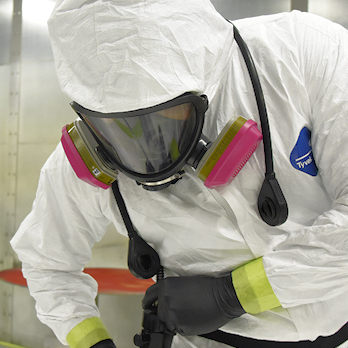Protective Clothing and Equipment
Employers must provide workers who are exposed to lead above the PEL or for whom the possibility of skin or eye irritation exists with clean, dry protective work clothing and equipment that are appropriate for the hazard. Employers must provide these items at no cost to employees. Appropriate protective work clothing and equipment used on construction sites includes:
- Coveralls or other full-body work clothing;
- Gloves, hats, and shoes or disposable shoe coverlets;
- Vented goggles or face shields with protective spectacles or goggles;
- Welding or abrasive blasting helmets; and
- Respirators.
Click on the link below to see the OSHA 1915 rules regarding the use of PPE while performing abrasive blasting on board a ship.
- Abrasive blasters working in enclosed spaces shall be protected by hoods and air fed respirators or by air helmets of a positive pressure type in accordance with the requirements of 1915.152(a).
- Abrasive blasters working in the open shall be protected as indicated in paragraph (c)(3)(i) of this section except that when synthetic abrasives containing less than one percent free silica are used jointly, filter type respirators approved jointly by the National Institute for Occupational Safety and Health and the Mine Safety and Health Administration for exposure to lead dusts may be used in accordance with § 1915.152(a) and (d).
- Employees, other than blasters, including machine tenders and abrasive recovery men, working in areas where unsafe concentrations of abrasive materials and dusts are present shall be protected by eye and respiratory protective equipment in accordance with the requirements of 1915.151(a) and (b) and 1915.152(a) and (d).
- The blaster shall be protected against injury from exposure to the blast by appropriate protective clothing, including gloves.
- Since surges from drops in pressure in the hose line can be of sufficient proportions to throw the blaster off the staging, the blaster shall be protected by a safety belt when blasting is being done from elevations where adequate protection against falling cannot be provided by railings.
Clean work clothing must be issued daily for employees whose exposure levels to lead are above 200 µg/m3, weekly if exposures are above the PEL but at or below 200 µg/m3 or where the possibility of skin or eye irritation exists.
Knowledge Check Choose the best answer for the question.
2-5. Clean work clothing must be issued daily for employees whose lead exposure levels to lead are above _____.
You forgot to answer the question!

